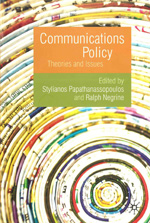Publications
Communications Policy: Theories and Issues
Communications Policy Theories and Issues
Edited by: Stylianos Papathanassopoulos , Ralph Negrine
Publisher: Palgrave Macmillan, 2010, p. 224
Culture, politics, economics and technology all impact upon policy decisions. To investigate the factors that influence communications policy, however, one has to go beyond conventional views of media and communication studies and combine these with policy studies. Communications Policy: Theories and Issues utilizes new research to highlight key debates and developments, and addresses a broad spectrum of contemporary concerns regarding the structure and the organization of communications systems in the past, present and future.
Combining theoretical analysis with empirical research findings, this comprehensive text explores the contemporary theories and issues in communications policy that affect all democratic societies as they seek to address the challenges of emerging information and communications technologies. Featuring contributions from distinguished authors across a range of media disciplines, Communications Policy introduces challenging ideas about how communications should be structured in the future and is essential reading for all policy makers, researchers and students of communications policy.
Contributors: Bram Abramson, Johannes M. Bauer, Sandra Braman, Dom Caristi, Alistair Duff, Gisela Gil-Egui, Alison Harcourt, Jackie Harrison, Robert W. McChesney, Serge Proulx, Marc Raboy, Concetta M. Stewart, Yan Tian and Roxanne Welters.
Contents:
Introduction - Stylianos Papathanassopoulos and Ralph Negrine
PART ONE: THEORIES
Approaches to Communications Policy: An Introduction - Stylianos Papathanassopoulos and Ralph Negrine
Mediating the Public Through Policy - Sandra Braman
The Past, Present and Future of Information Policy - Alistair Duff
Media and Social Demand: Research at the Interface of Policy Studies and Audience
Studies - Marc Raboy, Bram Abramson, Serge Proulx and Roxanne Welters
The Development of a European Civil Society Through EU Public Service Communication - Jackie Harrison
PART TWO: ISSUES
The Escalating War Against Corporate Media - Robert W. McChesney
The Role of the European Institutions in National Media Regulation - Alison Harcourt
Public Broadcasters in the Digital Era - Stylianos Papathanassopoulos and Ralph Negrine
Transformations of the State in Telecommunications - Johannes M. Bauer
Coordinating Internet Policies: Time has Come - Dom Caristi
Framing the Information Society: A Comparison of Policy Approaches by the US and the EU - Gisela Gil-Egui, Yan Tian and Concetta M. Stewart
Review
The editors acknowledge that they seek to advance the global and comparative aspects of research in the field - and this ensemble of selected chapters provides clear evidence of their success. The key thread of this compilation involves the foregrounding of the complexity of communications policy within contemporary society. The book's strength is that it engages the reader with nuanced debates and critically reflects upon an emerging, multi-faceted field.
Media International Australia
Overall, the book succeeds in giving a welcome and helpful glimpse into the field of communication and media policy today. It will be a useful companion to classes on policy and media systems.
European journal of Communication



